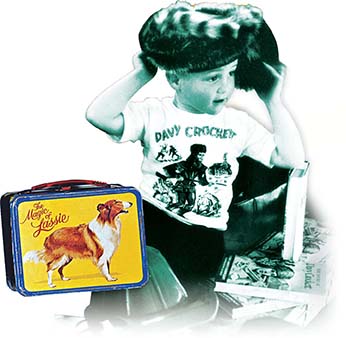SECTION 3: Mass Culture and Family Life

◄ Baby-boomer fads were often based on popular television shows.
WITNESS HISTORY  AUDIO
AUDIO
The Latest Fad
As baby boomers went to school, new fads came and went with amazing speed. One such fad revolved around a popular television show about the American folk hero Davy Crockett. Steven Spielberg, who later would become one of Hollywood’s most successful movie directors, recalled the craze.
“I was in third grade at the time. Suddenly, the next day, everybody in my class but me was Davy Crockett. And because I didn’t have my coonskin cap and my powder horn, or Old Betsy, my rifle, and my chaps, I was deemed the Mexican leader, Santa Anna. And they chased me home from school until I got my parents to buy me a coonskin cap.”
—Steven Spielberg, recalling the Davy Crockett craze of 1955
Objectives
- Explain why consumer spending increased.
- Discuss postwar changes in family life.
- Describe the rise of new forms of mass culture.
Terms and People
- consumerism
- median family income
- nuclear family
- Benjamin Spock
- rock-and-roll
- Elvis Presley
NoteTaking
Reading Skill: Identify Main Ideas Identify postwar changes in daily life and popular culture.
- The Culture of Consumerism
- Americans spend more
- Increased family income
Why It Matters During the 1950s, the ideal family was one in which men worked and supported their families and women stayed home and reared their children. Television and other forms of mass culture suggested that this ideal was the norm. Whether most American families actually lived like the ones they saw on prime-time television, however, remains unclear. The family values of the 1950s still affect who we are and who we want to be. Section Focus Question: How did popular culture and family life change during the 1950s?
The Culture of Consumerism
For much of our history, Americans had been taught to save their money. “A penny saved is a penny earned,” advised Benjamin Franklin. However, as the U.S. economy began to boom in the postwar era, Americans were caught up in a wave of consumerism, buying as much as they could, much of it on credit. What accounted for this spending spree?
Spending Is Easy
One reason Americans spent more was that they had more money to spend. During the 1950s, median family income, or average family income, rose from $3,319 to $5,417. The average American family now had twice as much real income as the average family had during the prosperous years of the 1920s. Consumer-oriented companies found new and innovative ways to encourage buying on credit. For example, General Motors advertised




